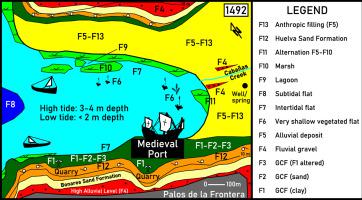Estuarine, Coastal and Shelf Science ( IF 2.6 ) Pub Date : 2021-01-06 , DOI: 10.1016/j.ecss.2020.107162 Marta Arroyo , Francisco Ruiz , Juan Manuel Campos , Javier Bermejo , María Luz González-Regalado , Joaquín Rodríguez Vidal , Luis Miguel Cáceres , Manuel Olías , Manuel Abad , Tatiana Izquierdo , Paula Gómez , Antonio Toscano , Verónica Romero , Gabriel Gómez

|
On August 3, 1492, Christopher Columbus departed from the port of Palos de la Frontera, located in a small cove in southwestern Spain, and returned to this same port on March 15, 1493. On the basis of sedimentology, geochemistry, paleontology and dating of a long core (18 m) collected in this cove, thirteen facies are distinguished in the Neogene-Holocene evolution of its sedimentary infilling, with a transition from Miocene marine environments to Late Holocene marshes, going through an intermediate period that includes fluvial gravels, alluvial sediments and shallow coastal deposits that characterize the maximum of the Fladrian transgression in this area (~6.5 cal kyr BP). These data and others contributed by historical sources allow an approximate reconstruction of this cove at the end of the 15th century.
中文翻译:

克里斯托弗·哥伦布从哪里开始?:历史时期的河口情景
1492年8月3日,克里斯托弗·哥伦布(Christopher Columbus)从位于西班牙西南部一个小海湾的帕洛斯·德拉弗龙特拉(Palos de la Frontera)港口出发,并于1493年3月15日回到同一港口。根据沉积学,地球化学,古生物学和测年在该海湾收集的长岩心(18 m)中,有13个相的特征是其新近纪-全新世沉积充填的演化,经历了从中新世海洋环境到晚新世沼泽的过渡,经历了包括河流砾石的中间时期,冲积沉积物和浅海沿海沉积物是该地区弗拉德海峡海侵的最大特征(约6.5千吉尔BP)。这些数据以及其他由历史资料提供的数据,可以在15世纪末大致重建该海湾。











































 京公网安备 11010802027423号
京公网安备 11010802027423号